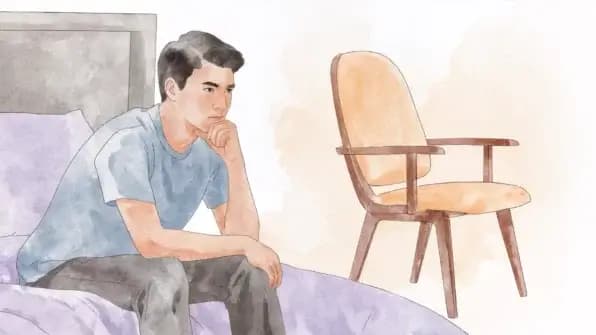Ever gotten so lost in your head so much that you completely forget what’s going on around you? Like, really lost? If this sounds familiar, you might be experiencing something more than just regular daydreaming.
We all daydream, but is it normal to daydream a lot? It’s okay to escape reality for a bit. But when the lines between imagination and existence blur, and daydreams take over your life, interfering with work, relationships, or just everyday stuff, it could be a sign of maladaptive daydreaming.
It’s like having an uncontrollable movie playing on repeat inside your head.
Wondering if this is happening to you? Take our maladaptive daydreaming test to figure it out.
“Do I experience maladaptive daydreaming?” Check with a maladaptive daydreaming test
Before taking the maladaptive daydreaming test, it’s helpful to reflect on your daydreaming patterns.
Consider how often you daydream, the intensity and vividness of your fantasies, and how much time you spend immersed in your inner world.
- Answer 18 questions about your daydreaming experiences in the past month (unless otherwise stated).
- Be honest with yourself about how your daydreaming affects your daily life, relationships, and ability to function.
This quiz is purely for the purposes of self-reflection and can help you better understand your experiences.
Take a free maladaptive daydreaming test
- I often find myself lost in detailed and elaborate fantasies.
- Strongly disagree (1 point)
- Disagree (2 points)
- Neutral (3 points)
- Agree (4 points)
- Strongly agree (5 points)
- My daydreams are so vivid that they feel more real than reality.
- Strongly disagree (1 point)
- Disagree (2 points)
- Neutral (3 points)
- Agree (4 points)
- Strongly agree (5 points)
- I have difficulty controlling or stopping my daydreams.
- Strongly disagree (1 point)
- Disagree (2 points)
- Neutral (3 points)
- Agree (4 points)
- Strongly agree (5 points)
- My daydreams interfere with my ability to focus on tasks or conversations.
- Strongly disagree (1 point)
- Disagree (2 points)
- Neutral (3 points)
- Agree (4 points)
- Strongly agree (5 points)
- I experience strong emotions within my daydreams.
- Strongly disagree (1 point)
- Disagree (2 points)
- Neutral (3 points)
- Agree (4 points)
- Strongly agree (5 points)
- I often use music to enhance my daydreaming experiences.
- Strongly disagree (1 point)
- Disagree (2 points)
- Neutral (3 points)
- Agree (4 points)
- Strongly agree (5 points)
- I engage in physical movements or gestures while daydreaming.
- Strongly disagree (1 point)
- Disagree (2 points)
- Neutral (3 points)
- Agree (4 points)
- Strongly agree (5 points)
- I feel disappointed or frustrated when my daydreams are interrupted.
- Strongly disagree (1 point)
- Disagree (2 points)
- Neutral (3 points)
- Agree (4 points)
- Strongly agree (5 points)
- My daydreams involve complex storylines and characters.
- Strongly disagree (1 point)
- Disagree (2 points)
- Neutral (3 points)
- Agree (4 points)
- Strongly agree (5 points)
- I find it difficult to connect with people in the real world when I am daydreaming.
- Strongly disagree (1 point)
- Disagree (2 points)
- Neutral (3 points)
- Agree (4 points)
- Strongly agree (5 points)
- I often daydream about ideal situations or relationships.
- Strongly disagree (1 point)
- Disagree (2 points)
- Neutral (3 points)
- Agree (4 points)
- Strongly agree (5 points)
- My daydreams provide an escape from boredom or unpleasant realities.
- Strongly disagree (1 point)
- Disagree (2 points)
- Neutral (3 points)
- Agree (4 points)
- Strongly agree (5 points)
- I feel a strong sense of attachment to my daydream characters.
- Strongly disagree (1 point)
- Disagree (2 points)
- Neutral (3 points)
- Agree (4 points)
- Strongly agree (5 points)
- My daydreams consume a significant amount of my time.
- Strongly disagree (1 point)
- Disagree (2 points)
- Neutral (3 points)
- Agree (4 points)
- Strongly agree (5 points)
- I have difficulty experiencing emotions in the real world compared to my daydreams.
- Strongly disagree (1 point)
- Disagree (2 points)
- Neutral (3 points)
- Agree (4 points)
- Strongly agree (5 points)
- I often daydream to avoid difficult emotions or situations in the real world.
- Strongly disagree (1 point)
- Disagree (2 points)
- Neutral (3 points)
- Agree (4 points)
- Strongly agree (5 points)
- My daydreams involve imaginary worlds or scenarios.
- Strongly disagree (1 point)
- Disagree (2 points)
- Neutral (3 points)
- Agree (4 points)
- Strongly agree (5 points)
- I feel a sense of emptiness or dissatisfaction when not daydreaming.
- Strongly disagree (1 point)
- Disagree (2 points)
- Neutral (3 points)
- Agree (4 points)
- Strongly agree (5 points)
As noted before, this quiz is purely for the purposes of self-reflection and introspection.
Scoring and interpretation of maladaptive daydreaming quiz
Good, you did it! Now, let’s interpret your results by calculating the total of your scores for all 18 questions.
- Low score (18-45): You likely do not experience maladaptive daydreaming. Daydreaming is a typical human experience, and occasional, enjoyable daydreams are healthy.
It’s important to maintain balance. Ensure that your daydreaming doesn’t significantly interfere with your daily life, relationships, or responsibilities.
Try to engage in various activities to prevent boredom, set aside specific times for relaxation and daydreaming, and cultivate mindfulness to stay present.
- Moderate score (46-72): In this case, maladaptive daydreaming might be starting to get in the way a little. You might find yourself zoning out or having trouble connecting with people.
Maladaptive daydreaming can make it difficult to concentrate, maintain relationships, or experience emotions in the real world.
Consider developing new hobbies, such as painting, biking, or trying qigong, to distract yourself from excessive daydreaming.
- High score (73-90): Your maladaptive daydreaming will likely significantly impact your life. If you’re struggling with work, school, or relationships because of it, it’s definitely time to reach out for help.
Take care of your mental health. Prioritize self-care activities like getting enough sleep, maintaining a balanced diet, and spending time in nature. Practice being mindful and meditation, and seek support from friends or family to share your feelings.
It’s important to note that maladaptive daydreaming can sometimes be a sign of childhood trauma, anxiety disorders, or depression. These conditions often coexist with maladaptive daydreaming, and addressing the underlying issues can be crucial for improving overall well-being.
Maladaptive daydreaming test: FAQ
Is a maladaptive daydreaming quiz trustful?
The maladaptive daydreaming test is based on the MDS-16, developed by Eli Somer and colleagues in 2016. MDS-16 is a self-report questionnaire used to identify potential maladaptive daydreaming.
While it’s not a replacement for professional help, it can offer insights into whether you might be struggling. Think of it as a helpful starting point.
Should I be concerned if I score high?
A high score doesn’t necessarily mean your daydreaming is problematic. It could indicate a tendency towards it, but other factors need to be considered.
Maladaptive daydreaming & daydreaming: Is there any difference?
Daydreaming is a common, brief mental escape. Maladaptive daydreaming is excessive, consuming fantasy that interferes with daily life.
For example, you may briefly daydream about vacation (daydreaming). But if you spend hours daily in vivid, detailed fantasies, neglecting work and relationships (maladaptive daydreaming)
If I have MD, does it mean there is something wrong with me?
Enna Sanghvi, MA, says, “No, not at all! If you experience maladaptive daydreaming, it is definitely something to make a note of and be aware about. Learning how to balance daydreaming with other coping mechanisms can help.
Using only daydreaming as a coping mechanism, or for that matter any one type of coping mechanism, isn’t always helpful. It is good to have as many tools in your toolbox as possible!”
Is maladaptive daydreaming rare?
Not as rare as previously thought: While it was once considered rare, studies suggest that maladaptive daydreaming affects around 2.5% of the population. This means millions of people worldwide experience it.
What are the reasons for MD?
While the exact causes aren’t fully understood, maladaptive daydreaming might serve as a coping mechanism.
It can be brought on by:
- As a response to trauma, by emotional neglect or emotional abuse
- Anxiety or depression
- Loneliness, isolation, or boredom
- Difficulty coping with reality, feeling like a failure
- ADHD, OBC, or other conditions that might contribute to increased daydreaming tendencies
Does maladaptive daydreaming go away?
“It can be possible! Engaging in various different kinds of coping skills as opposed to only relying on daydreaming can increase the number of options you have to choose from when using a coping skill. Again, it is good to have as many tools in your toolbox as possible!” shared Enna Sanghvi, MA.
Disclaimer
This article is for general informative and self-discovery purposes only. It should not replace expert guidance from professionals.
Any action you take in response to the information in this article, whether directly or indirectly, is solely your responsibility and is done at your own risk. Breeze content team and its mental health experts disclaim any liability, loss, or risk, personal, professional, or otherwise, which may result from the use and/or application of any content.
Always consult your doctor or other certified health practitioner with any medical questions or concerns
Breeze articles exclusively cite trusted sources, such as academic research institutions and medical associations, including research and studies from PubMed, ResearchGate, or similar databases. Examine our subject-matter editors and editorial process to see how we verify facts and maintain the accuracy, reliability, and trustworthiness of our material.
Was this article helpful?






